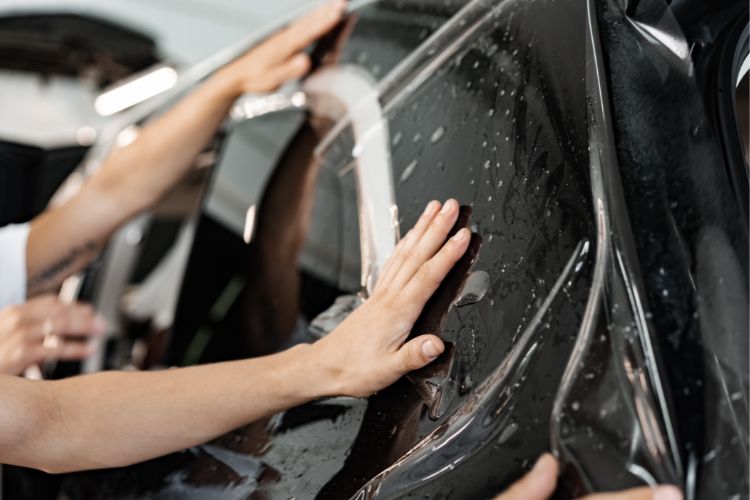Stickers: The Difference Between Regular and Sun/Water-Resistant Types
Stickers are a rapidly spreading means of decoration and advertising in the automotive world. Whether you want to personalize your car with a unique design or represent a company promoting its brand through mobile vehicle decals, stickers offer versatile solutions. As their popularity grows, so does the variation in their quality and applications. This highlights the distinction between regular stickers (typically used for indoor or temporary purposes) and sun/water-resistant stickers (specifically engineered for outdoor use and harsh environmental conditions).
This article aims to illuminate the core differences between these two types, outline key considerations when choosing the right sticker for your car, and detail the technical and practical aspects that make sun/water-resistant stickers the optimal choice for outdoor environments.
The Importance of Stickers in the Automotive World
Stickers serve purposes beyond aesthetics in vehicles:
- Promotion & Advertising: Companies use stickers as mobile billboards to display logos and offers on car surfaces.
- Personal Expression: Car enthusiasts decorate vehicles to showcase hobbies, sports teams, or personal style.
- Informational Guidance: Businesses use stickers as instructional or warning labels (e.g., on windows or rear panels).
Given environmental challenges like direct sunlight, rain, and dust, selecting the right sticker type is critical to preserving both design integrity and durability.
Defining Regular Stickers
Regular stickers are traditional types made from paper or lightweight materials coated with basic ink or laminate. Key characteristics include:
- Easy Production: Printable using home or small-scale printers.
- Cost-Effective: Low production costs suit tight budgets.
- Temporary Use: Ideal for short-term projects like events or exhibitions.
Limitations:
- Unsuitable for outdoor conditions; prone to peeling, fading, and discoloration when exposed to moisture or UV rays.
- Not recommended for vehicles facing weather extremes.
Sun/Water-Resistant Stickers: The Optimal Choice for Vehicles
Unlike regular stickers, sun/water-resistant stickers are engineered to withstand harsh outdoor elements. Key differentiators include:
1. Materials Used
- Crafted from durable substrates like vinyl or specialized polymers resistant to high temperatures and humidity.
- These materials prevent peeling and color fading under prolonged sun/rain exposure.
2. Printing Technology
- Utilizes advanced techniques like UV printing and thermal printing with UV/heat-resistant inks.
- Features transparent protective layers that enhance scratch resistance and design clarity.
3. Flexibility & Durability
- High flexibility allows seamless adhesion to curved car surfaces without cracking.
- Maintains quality despite vibrations, temperature fluctuations, and environmental stressors.
4. Practical Application on Vehicles
- Preserves design integrity long-term; resists fading during car washes or dust exposure.
- A cost-effective investment for lasting aesthetic appeal.
Detailed Comparison: Regular vs. Resistant Stickers
Applications of Resistant Stickers in Automotive Use
- Advertising:
- Transforms cars into mobile billboards; maintains brand image without degradation.
- Personalization:
- Enables custom designs (e.g., vibrant graphics) that endure sun/rain.
- Warning/Informational Labels:
- Displays safety instructions or directional cues on commercial vehicles.
- Customization & Uniqueness:
- Allows personal branding (names/logos) for standout vehicle identity.
Key Considerations When Choosing Car Stickers
- Environment:
- Opt for resistant stickers in harsh climates (heat, rain, humidity).
- Duration of Use:
- Long-term campaigns/permanent decor require resistant types.
- Budget:
- Resistant stickers justify higher costs through longevity.
- Design Compatibility:
- Ensure designs align with advanced printing capabilities (e.g., UV inks).
- Maintenance & Installation:
- Resistant vinyl stickers offer easy cleaning and curved-surface adhesion.
Technological Advancements in Vehicle Stickers
Recent innovations include:
- Enhanced ink adhesion and long-term color stability.
- Diverse finishes (glossy, matte, textured).
- Superior corrosion resistance against environmental wear.
- Precision cutting technologies for seamless application.
These advancements position sun/water-resistant stickers as strategic solutions for modern vehicle customization.
Pre-Printing/Application Tips for Users
- Request Samples: Test quality and durability before bulk orders.
- Verify Ink Type: Ensure UV/moisture-resistant inks are used.
- Size Appropriately: Match sticker dimensions to vehicle surface area.
- Partner with Specialized Printers: Guarantee industry-standard quality and technical support.
- Design Strategically: Prioritize contrast/clarity for logos or messages.
Conclusion
The fundamental difference between regular and sun/water-resistant stickers lies in durability and environmental resilience. For vehicles exposed daily to sunlight, rain, and dust, resistant stickers are essential to preserve design aesthetics and longevity.









